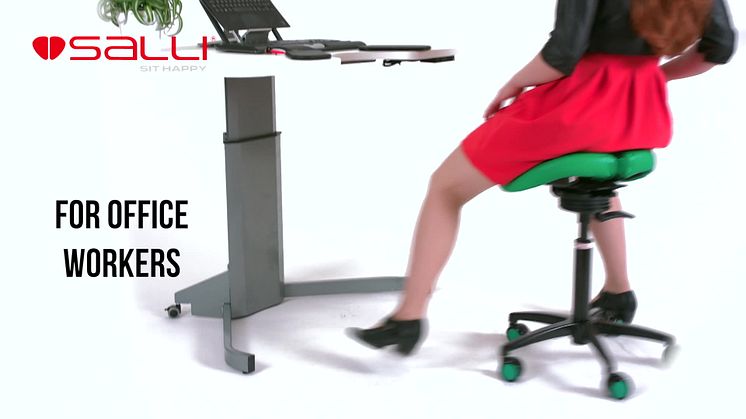Press release -
Biohacker claims: You can prevent osteoarthritis yourself
About half of the 50-year-old Finns suffer from some degree of changes in their joints. But you don’t have to be helpless when facing the symptoms, but there are a lot of things you can do to better the situation. It is worthwhile to pay attention to sitting and working positions, and to your diet.
Arthritis develops individually as the result of the environmental conditions, ergonomics, nutrition, weight, exercise routines and genes. Different factors of sitting and sitting position have a clear impact on the joints in four major areas: neck shoulders, back and lower limbs. Musculoskeletal Disorders (MSD) have a close link with the development of arthritis. For example, a joint once injured in an accident or playing sports is more prone to suffering from arthritis at some point.
Shoulders, back and neck
Bad sitting posture easily forms over a 30 degree angle between the upper arms and upper body. An angle this big is typically thought to be a risk for the shoulder joints, especially if long-lasting tasks are conducted with the hands at the same time. In a posture like this the metabolism in the shoulders is reduced, and the joints suffer more easily of erosion and other deteriorative damages. This ailment is typical among, for example, dentist.
Bad postures of the lower back cause uneven and increased compression pressure on the disks when the vertebrae are "ajar” and the facet joints cannot carry their part of the load (30 %). Sitting with the back rounded stretches the soft tissues around the vertebrae of the lower back, causing tension in the ligament tissues.
These tensions dramatically weaken blood circulation in the area, consequentially reducing the oxygen and nutrient intake of the disks, ligaments and bones. Discs, vertebrae and ligaments have hardly any circulation of their own, so their nutrient and oxygen intake is vitally depending on the nearby tissues fed by active blood circulation.
In the conventional sitting position the hip and knees form a 90-90 degree angle. The neck vertebrae are in unnatural position to one another in traditional sitting, which generally causes arthritis in the neck vertebrae in the middle age. The muscles are tense and sore years before the actual joint problems appear.
Wrong and increased pressure and shortage of oxygen and nutrients are actually the two main factors damaging the lower back, and together they cause deterioration and osteoporosis. Sitting in a bad posture, with the neck and upper back in incorrect positions, increase the occurrence of arthritis in the upper back and cervical vertebrae.
Lower limbs are in the key position
As a long lasting position sititng in 90 degree angle is harmful to the joints, as they should be straightened out more out and be more mobile. Tightness occur also in many ligaments and deep muscles in the pelvic-thigh–knee area causing easily in the long run many disorders that can reflect as pain in numerous tissues in the area.
In the hip the upward pressure of the chair in 90 - 90 degree sitting increases pressure on the cartilage on the upper surface of the hip joint. Nowadays we sit normally 10-16 hours a day on various seats all along the day. So the pressure is on the joint all this time. Long term pressure in the cartilage prevents normal metabolism and so the tissues start to degenerate into arthritis.
In the knee the 90 degree angle makes patella and Tibialis tendons very tight, increasing the unnatural static pressure to the cartilage and thus speeding up the beginning of arthritis. In addition, the knees that have been passive when you were sitting are suddenly hit with a harmful pressure impulse every time you stand up from the 90 degree angle. Anyone can notice the discomfort or pain in the lower limb joints caused by long-term sitting as one stands up after a long flight or a car trip.

Ailments can be prevented
The development of all these joint problems can largely be prevented by maintaining a sitting position in which the back is in a good posture at all times, head is held straight and hips and knees form at least a 135-135 degree angle.
The easiest way to achieve this is to use a saddle chair that has a two-part seat. That will keep the user’s pelvis in an upright position, as if they were standing, and the seat supports the weight on the sitting bones. The genitalia are well ventilated and no harmful pressure is concentrated on the area, which makes it easy to maintain the correct posture in the pelvis considering, that too tight clothes are not preventing the correct pelvic posture.
Pay attention to sitting position
The joint-friendly working environment includes much more motion than before. Its good to stand 15 -20 min periods as you feel like it. Seat with swinging mechanism create micro motion (sit & swing) in the lumbar–pelvic–area. Place is finalized by an electronically adjustable table that has different pre-set height settings and soft elbow pads under the shoulder line. There should also be a high-quality monitor (or rather 2-3 monitors because of the efficiency of the work and the movements of the neck) situated on the right height (upper edge on the same level with the eyes). In addition, joints and muscles benefit from a working environment that has been designed so that the person needs to roll back and forth to pick up and reach (roll & reach) for items while sitting on the chair.
Getting up from the chair every now and then and walking some stairs (walk & talk) or at least some dozens of steps is also good for you. Use a hands-free Bluetooth while talking on the phone. With your hands free you can walk, stretch or even exercise with variable equipment without the call being disturbed. Definitely have a walking/exercise break once every hour at least. These movements activate the metabolism in cartilage of the joints and strengthen the muscles, which helps the joints to remain healthy.

Nutritional supplements are helpful
Many special nutrients have been found to be useful in maintaining the health in the joints or even healing the problems. They are metylsulfonylmetane (MSM), vitamin D, magnesium (Mg), Omega 3 fat acids up to 3 g/day, calcium (Ca), ginger, protease enzyme, serrapeptazic enzyme, chondroitin sulfate extract, cissus herb, chodroitin sulfate and other antioxidants, because joint problems are inflammatory diseases. Also it´s useful to use shark cartilage and green-lipped mussel (Perna canaliculus)concentrates.
Mistletoe can be used as medicine for degenerated joints as well as some spices which have joint health impacts like basil, capers, chervil, savory, and bay leaf.
Avoiding obesity and carrying heavy loads are also meaningful. According to my own experience magnet therapy, electric acupuncture and special diets can have significant therapeutic impacts as well. It can be worthwhile to place the bed outside the so called “earth radiation” i.e. “water vein” fields.
On my opinion these preventive measures can prevent osteoarthritis and alleviate the symptoms if you already have it.
Veli-Jussi Jalkanen
biohacker
expert on preventive medicine
agronomist, farmer
chairman of the board, Salli Systems
Related links
Topics
- Business enterprise
Categories
- good position
- finland
- office chair
- work chair
- saddle chair
- salli
- ergonomics
- health
- healthy
- finnish
- preventive
- joint health
- joints
- sitting
- ergonomic
Salli Systems is the leading manufacturer of saddle chairs in the world. The Finnish company has been developing the optimum seating concept since 1990, and holds now two worldwide patents. Salli’s invention, the two-part saddle chair that has an active seat, solves the classic problem of how to sit without disturbing one’s circulation and metabolism and thus one’s health and productivity. Salli Systems produces saddle chairs, electrically adjustable tables, and accessories; the products are exported to more than 60 countries.




